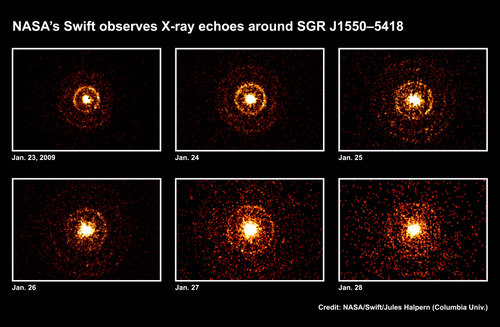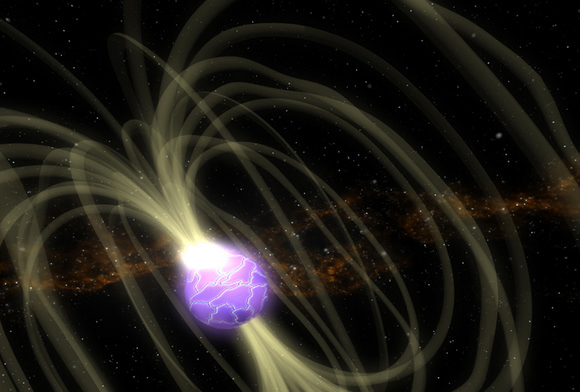[/caption]
NASA’s Swift satellite and Fermi Gamma-ray Space Telescope have keyed in on a rowdy stellar remnant 30,000 light-years away. The object, already known as a source of pulsing radio and X-ray signals, lies in the southern constellation Norma. It kicked out some moderate eruptions in October, but then it settled down again. Late last month, it roared to life.
“At times, this remarkable object has erupted with more than a hundred flares in as little as 20 minutes,” said Loredana Vetere, who is coordinating the Swift observations at Pennsylvania State University. “The most intense flares emitted more total energy than the sun does in 20 years.”
The new object has been cataloged as SGR J1550-5418. Because of the recent outbursts, astronomers will classify it as a soft-gamma-ray repeater. Only six such objects are known to science, and they share the trait that they unpredictably send out a series of X-ray and gamma-ray flares. In 2004, a giant flare from another soft-gamma-ray repeater was so intense it measurably affected Earth’s upper atmosphere from 50,000 light-years away.
The source of the wild emissions is probably a spinning neutron star — the superdense, city-sized remains of an exploded star. Measuring only about 12 miles (19 kilometers) across, a neutron star is more massive than the sun.
While neutron stars typically possess intense magnetic fields, a subgroup displays fields 1,000 times stronger. These so-called magnetars have the strongest magnetic fields of any known objects in the universe. SGR J1550-5418, which rotates once every 2.07 seconds, holds the record for the fastest-spinning magnetar. Astronomers think magnetars power their flares by tapping into the tremendous energy of their magnetic fields.
Fermi’s gamma-ray burst monitor is designed to investigate magnetar flares, and SGR J1550-5418 has already triggered the instrument more than 95 times since Jan. 22. Swift’s X-ray telescope captured the first “light echoes” ever seen from a oft-gamma-ray repeater when SGR J1550-5418 started exploding. Both the halo-like rings and their apparent expansion are an illusion caused by the finite speed of light and the longer path the scattered light must travel. NASA’s Wind satellite, the joint NASA-Japan Suzaku mission, and the European Space Agency’s INTEGRAL satellite also have detected flares from SGR J1550-5418.



I’m hoping that someone can answer this; is there anyway to estimate the age of these stars?
I only ask because it seems like these things are just starting to pop into existence. Should we be expecting more of these in the future, or are they a rare “breed” of star?
They are not popping into existence… they are just being discovered. They are probably millions or billions of years old, though I’m no expert on the subject. I think the more active ones are a bit younger, possibly “only” thousands of years.
It just seems like because so few are known about, that they are young magnetars, but old stars in general. Perhaps some of the oldest?
I was hoping an expert on the matter could say one way or another.
My only thinking is these amazing objects was a massive star perhaps 8-20x the mass of the Sun that exploded as a Type 2 supernova and collapsed into a neutron star (the massive star was probably only about 50M years old before collapse and explosion) These strange magnetars have to be relatively young, IMHO about 10K years. It just amazes me how so much incredibly strong energy can come from something so small.
I’m glad such magnetars and SGR J1550-5418 are quite far away
Magnetars are believed to be a rare and temporary phase of (some) neutron stars, so at any time there will not be that many around. Little are known about neutron stars, even less about magnetars.
It is believed that the intense magnetic field of a magnetar (many-many times larger than more normal neutronstars) causes the star to put on the brakes on rotation, slowing them down much quicker, and that the SGR-phase lasts perhaps a few thousand years. The outbursts is part of the ‘tapping’ of the rotation by magnetic braking (or so believed)
‘Dead’ magnetars, ones that have slowed down to a crawl in rotation, are probably much more common, but they might not show themselves by any currently measurable means.
Great question about the age of SGR J1550-5418. I’ve emailed one of the researchers to ask, and hopefully will be able to post an answer soon.
Although i am nowhere near an expert on this feed, I know there are quite a few different types of massive stars in various stages of aging/development, about 8-20x mass of the Sun that will collapse and explode as various type 2 or type 1b,1c leaving just enough mass to create a neutron star. What type massive stars will cause a different type neutron star- a magnetar, is probably something just beyond the ability of the various orbiting detectors. I understand there is perhaps 1 supernova every 50 or so years in a galaxy our size, perhaps more but blocked from view or detectors as they are on the other side of our galaxy, hidden from the ‘noise’ and dust thru the center of our Milky Way Galaxy. With improved mapping and detectors, hopefully a relatively close
type 2 or 1b,1c supernova will occur in a galaxy with the progenitor star recognized
and cause a magnetar type neutron star
creation. However, I would like to see the
results of the age of SGR J1550-5418
from the researchers.
“Astronomers think magnetars power their flares by tapping into the tremendous energy of their magnetic fields.”
Magnetic fields are only caused by electric currents.
“The object, already known as a source of pulsing radio and X-ray signals…” Both radio and X-rays are known to be caused by accelerating electrons in a magnetic field, a phenomenon of electromagnetism.
“[T]his remarkable object has erupted with more than a hundred flares in as little as 20 minutes,” said Loredana Vetere…”
The outburst begins with a sudden peak of energy, and then declines gradually, consistent with scalable plasma physics experiments in the laboratory. Plasma physicists observe ‘double layers’, which are capacitor-like structures that form wherever current flows in plasma. Occasionally they release stored electrical energy in an explosive discharge producing gamma rays.
Where there are magnetic fields there must be electric currents.
“The new object has been cataloged as SGR J1550-5418. Because of the recent outbursts, astronomers will classify it as a soft-gamma-ray repeater.”
This is actually not entirely correct. Initially, when it first exhibited a series of bursts last year, it was named SGR J1550-5418. The exact localization via an X-ray counterpart then made it clear that the source was known beforehand as an Anomalous X-ray Pulsar, AXP 1E1547.0-5408 (something like a “little brother” of SGRs). But the activity seen now goes much beyond typical AXP activity and is characterstic of SGRs. Therefore, it is some kind of transition object, which makes it highly interesting.
Excalibur has it right, magnetars are very young objects, not more than 10K years old. After that time, their activity subsides as they do not rotate fast enough anymore.
Thanks for the input guys.
Anne Minard, I’m very interested in what the experts are going to say on this.
Loredana Vetere, the Swift researcher quoted in the story (from Pennsylvania State University), responded this way in an email:
As somebody else already pointed out SGRs are very young objects since they all lie in supernova remnants (SNRs) with ages < 10,000 years (in which they presumably formed).
She also said she’s impressed with the quality of the comments. I am too!
Well, I was partly right at least. =) I kind of figured the active ones might be only thousands of years old.
Anaconda: “Magnetic fields are only caused by electric currents. […] Where there are magnetic fields there must be electric currents.”
I would suggest that you throw those bloody 19th century text books of yours into the rubbish bin where they belong.
There are, in fact, TWO kinds of magnetic sources: (1) motion of ELECTRIC CHARGES, such as electric currents, and (2) the INTRINSIC MAGNETISM of elementary particles, such as the electron.
I would also suggest that you acquaint yourself on quantum mechanics and spin physics — http://tinyurl.com/66pjc4 — before you parrot that “Electric Universe/Plasma Cosmology” diatribe here.
We at Bad Astronomy would not buy your jabberwocky; so, what makes you think that readers here will do so?